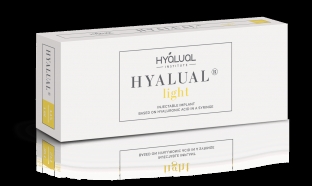The consequences of acne cause anxiety to patients and spoil their quality of life no less than the actual inflamed elements of acne. Scars, congestive spots, enlarged pores and other manifestations of post-acne are difficult to correct, require scrupulous and expensive treatment, but even the efforts made do not always live up to expectations. Readers of estet-portal.com are offered a description of their personal experience with the use of post-acne skin redermalization, when the combined preparation Hyalual with succinic and hyaluronic acids was used for treatment.
 Yulia Kachuk – shared her experience of effective therapy; Candidate of Medical Sciences, Associate Professor, Department of Dermatovenereology, Kharkiv Medical Academy of Postgraduate Education.
Yulia Kachuk – shared her experience of effective therapy; Candidate of Medical Sciences, Associate Professor, Department of Dermatovenereology, Kharkiv Medical Academy of Postgraduate Education.
What is the relevance of the post-acne problem, and how can a beautician help in solving it?
Acne is one of the world's most common diseases of the sebaceous glands and hair follicles of the skin. The peculiarity of the disease is that after stopping the acute phase of inflammation, post-inflammatory skin changes occur, and they cause patients no less suffering than the inflammatory process itself. Post-acne usually manifests itself:
- persistent erythema and dilated skin capillaries;
- scars and enlarged pores;
- congestive spots and pigmentation disorders;
- uneven skin texture.
The degree of manifestation of post-inflammatory skin changes depends on the timeliness of the treatment started, on the severity of the forms of inflammatory elements on the skin and on the duration of the inflammatory process, on the age of the patient and many other reasons.
Unfortunately, today there are no such methods of post-acne systemic therapy that would completely save the patient from already formed skin defects. To correct the condition, dermatologists use hardware procedures (laser and phototherapy), injection methods, chemical peels, in especially severe cases they recommend the intervention of a plastic surgeon.
The goal of influencing the consequences of acne is not only to consolidate the results of previous conservative treatment, but also to improve the patient's appearance.
When it comes to the correction of post-acne scars, mild to moderate acne, glycol and trichloroacetic chemical peels give a good effect. Laser resurfacing, dermabrasion, phenol peeling are allowed only after the process of skin scarring is completed and other correction methods are not effective. In any case, a program for the correction of post-acne manifestations is individually compiled for the patient with a choice of optimal procedures that will prevent side effects of acne therapy and the risk of skin defects, improve the patient's quality of life and reduce his worries about appearance defects.
Why is redermalization effective in post-acne therapy?
A chronic inflammatory process in acne and post-acne covers the sebaceous glands and the space around them in the dermal layer of the skin. Due to inflammation, the dermal layer is damaged, the life resource of its cells is depleted, metabolic processes in the dermis are disrupted. For successful post-acne therapy, it is necessary to restore the full functioning of the dermis.
Redermalization – restoration of the vital resource of the dermis by intradermal injections. The synergistic effect of injectable preparations, where succinic and hyaluronic acids are combined, gives a pronounced restorative effect.
The use of redermalization in post-acne therapy is based on the enhancement of skin microcirculation. When, after the injection of the drug, the gaps in the capillaries normalize and the elasticity of the vascular walls increases, the vascular inflammation gradually disappears, which means that the erythema decreases and gradually disappears. Congestion spots and hyperpigmentation become less noticeable due to the enhancement of the regenerative capabilities of the skin.
The role of hyaluronic acid in this tandem for redermalization is to maintain intercellular and cellular homeostasis, moisturize the skin, and form the intercellular matrix.
Succinate, or 1.6% sodium succinic acid, has powerful antioxidant and regenerative properties. Succinic acid is able to actively block free radicals, improve metabolic processes in the skin, stimulate the proliferation of fibroblasts, and improve microcirculation.
Increased production of fibroblasts after the redermalization procedure triggers the synthesis of new collagen and enhances the production of its own hyaluronic acid. The result of such processes in the skin is a significant improvement in its texture and appearance.
Practical experience of post-acne correction using redermalization technique
Clinical effects of redermalization in post-acne therapy were evaluated based on the results of the procedure in 20 patients aged 16-27 years.
Means and methods. When using the redermalization method, a combined preparation was used, which included hyaluronic acid (1.1%) and sodium succinic acid (1.6%).
Performing a procedure. The bottom of each post-acne scar was separated with the tip of a needle using a semi-linear technique. Injections of the drug were made intradermally papularly along the massage lines. Papule diameter – 2 mm, distance between injections – 0.5 cm. At the end of the procedure, the skin was treated with a disinfectant solution, then an antiseptic cream was applied. The procedure was carried out once every two weeks and repeated 4-6 times.
The result of the procedure. Subjectively, all patients noted a decrease in skin discomfort after the second procedure, a decrease in the severity of erythema, skin flaking, and a moderate reduction in pores. Objectively, according to the results of the completed course of redermalization procedures, it was recorded:
- reduction of oily skin and significant smoothing of its relief;
- absence of stagnant spots and reduction in the severity of hyperpigmentations;
- improvement of post-acne scars.
Three months after the redermalization, all post-acne manifestations on the face almost completely disappeared, with the exception of chipped atrophic scars.

Thus, when correcting post-acne, redermalization by intradermal injections of the combined preparation Hyalual with succinic and hyaluronic acids improved the aesthetic appearance of the skin and reduced the time it took to recover from the disease, prevent pathological scarring, and significantly minimize the prescription of other methods of treatment skin with post-acne.









Add a comment